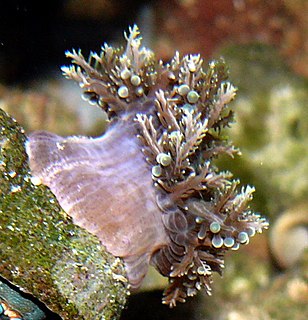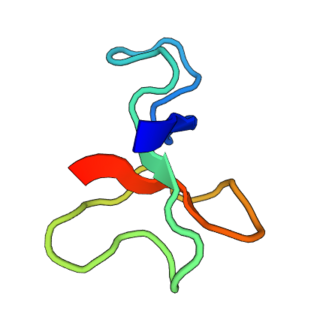
Delta atracotoxin is a low-molecular-weight neurotoxic polypeptide found in the venom of the Sydney funnel-web spider.

Sea anemone neurotoxin is the name given to neurotoxins produced by sea anemones with related structure and function. Sea anemone neurotoxins can be divided in two functional groups that either specifically target the sodium channel or the potassium channel.

Stichodactyla helianthus, commonly known as sun anemone, is a sea anemone of the family Stichodactylidae. Helianthus stems from the Greek words ἡλιος, and ἀνθος, meaning flower. S. helianthus is a large, green, sessile, carpet-like sea anemone, from the Caribbean. It lives in shallow areas with mild to strong currents.
Birtoxin is a neurotoxin from the venom of the South African Spitting scorpion. By changing sodium channel activation, the toxin promotes spontaneous and repetitive firing much like pyrethroid insecticides do
AETX refers to a group of polypeptide neurotoxins isolated from the sea anemone Anemonia erythraea that target ion channels, altering their function. Four subtypes have been identified: AETX I, II, III and K, which vary in their structure and target.
BmKAEP is a neurotoxin from the venom of the Manchurian scorpion (Mesobuthus martensii). It is a β-toxin, which shift the activation voltage of sodium channels towards more negative potentials.
Huwentoxins (HWTX) are a group of neurotoxic peptides found in the venom of the Chinese bird spider Haplopelma schmidti. The species was formerly known as Haplopelma huwenum, Ornithoctonus huwena and Selenocosmia huwena. While structural similarity can be found among several of these toxins, HWTX as a group possess high functional diversity.
Halcurin is a polypeptide neurotoxin from the sea anemone Halcurias sp. Based on sequence homology to type 1 and type 2 sea anemone toxins it is thought to delay channel inactivation by binding to the extracellular site 3 on the voltage gated sodium channels in a membrane potential-dependent manner.
Calitoxin, also known as CLX, is a sea anemone neurotoxin produced by the sea anemone Calliactis parasitica. It targets crabs and octopuses, among other invertebrates. Two isoforms have been identified, both of which are formed from precursors stored in the stinging cells of the anemone. Once the toxin is activated and released, it causes paralysis by increasing neurotransmitter release at invertebrate neuromuscular junctions. Along with several other toxins derived from anemones, CLX is useful in ion channel research. Certain structural aspects of calitoxin are dissimilar from sea anemone toxins that also target the sodium ion channels. Other toxins resembling calitoxin function in completely different ways.
Cangitoxin, also known as CGTX or CGX, is a toxin purified from the venom of the sea anemone Bunodosoma cangicum, which most likely acts by prolonging the inactivation of voltage-gated sodium channels.
CgNa is a peptide toxin isolated from the sea anemone Condylactis gigantea. It causes an increased action potential duration by slowing down the inactivation of tetrodotoxin-sensitive sodium channels.
Kaliseptine (AsKS) is a neurotoxin which can be found in the snakelocks anemone Anemonia viridis. It belongs to a class of sea anemone neurotoxins that inhibits voltage-gated potassium channels.
Blood-depressing substance-1 (BDS-1), also known as kappa-actitoxin-Avd4a, is a polypeptide found in the venom of the snakelocks anemone Anemonia sulcata. BDS-1 is a neurotoxin that modulates voltage-dependent potassium channels, in particular Kv3-family channels, as well as certain sodium channels. This polypeptide belongs to the sea anemone type 3 toxin peptide family.
SHTX is a toxin derived from the sea anemone Stichodactyla haddoni; there are four different subtypes, SHTX I, II, III and IV. SHTX I, II and III can paralyze crabs by acting on potassium channels, while SHTX IV works on sodium channels, and is lethal to crabs.

Heterodactyla hemprichii is a species of sea anemone in the family Thalassianthidae. This sea anemone does not host any varieties of clownfish, but has been associated with some species of commensal anemone shrimp. This is a medium to large species of anemone characterized by "bunches of grape-like nematospheres," radially arranged, and densest on the outermost edges of its oral disc.

Thalassianthus aster is a species of sea anemone in the family Thalassianthidae. It dwells in a number of habitats, even existing symbiotically on top of other motile invertebrates such as hermit crabs in a relationship similar to the pom pom crab. Its nematocysts contain a Type-II Na+-channel toxin known as δ-TLTX-Ta1a according to the currently developing systematic nomenclature for peptide and protein toxins from sea anemones.

BcIII is a polypeptide sea anemone neurotoxin isolated from Bunodosoma caissarum. It targets the site 3 of voltage-gated sodium channels, thus mainly prolonging the inactivation time course of the channel.
ATX-II, also known as neurotoxin 2, Av2, Anemonia viridis toxin 2 or δ-AITX-Avd1c, is a neurotoxin derived from the venom of the sea anemone Anemonia sulcata. ATX-II slows down the inactivation of different voltage-gated sodium channels, including Nav1.1 and Nav1.2, thus prolonging action potentials.
APETx1 is a peptide toxin from the venom of the sea anemone Anthopleura elegantissima. The toxin acts as a gating modifier on the human ether-à-go-go-related gene (hERG) channel, a type of voltage-gated potassium channel, and as a blocker of voltage-gated sodium channels, including Nav1.2 and Nav1.8.
Neurotoxin B-IV is a venom peptide secreted by a large marine worm called Cerebratulus lacteus that inhabits the northeastern coast of North America. This neurotoxin belongs to a major type of B polypeptide neurotoxins, which appear to be selectively toxic for crustaceans. The mode of action for neurotoxin B-IV has not been clearly established. However, it is likely that B neurotoxins prolong the repolarization phase of action potentials by interacting with voltage-gated sodium channels.






